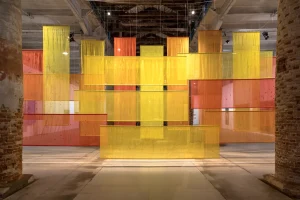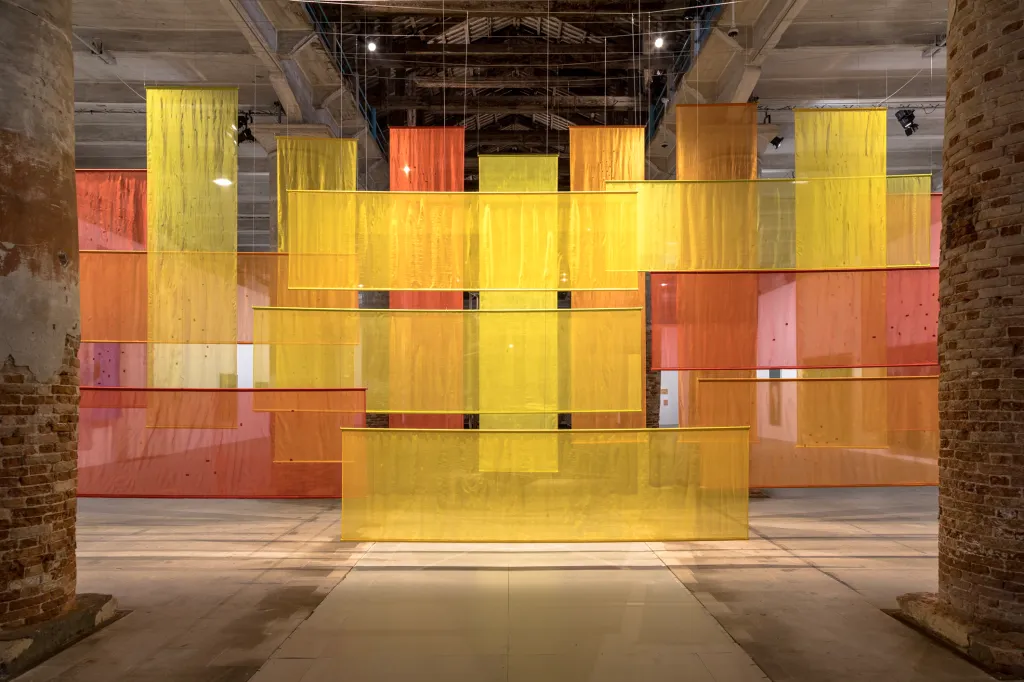Palestinian Saudi artist Dana Awartani will represent Saudi Arabia at the 2026 Venice Biennale. Her pavilion will be curated by Antonia Carver, director of Art Jameel, with assistance from Hafsa Alkhudairi.
Awartani has been a fixture of the international biennial circuit in recent years, earning acclaim for her material interpretations of conflict in the Middle East. Her practice draws on Saudi Arabia’s craft and cultural legacies, and she collaborates regularly with local artisans or displaced craftspeople.
She was born and raised in Jeddah to a Saudi mother and a Palestinian father and received a BA from Central St Martins in London. Her work is informed by her subsequent training in Islamic geometry at the Prince’s School of Traditional Arts and in illumination in Turkey, where she completed a formal apprenticeship in the centuries-old discipline.
She has earned acclaim for her material interpretations of conflict in the Middle East. Her practice draws on Saudi Arabia’s craft and cultural legacies, often in collaboration with local artisans or displaced craftspeople. While she received a BA from Central Saint Martins in London, her oeuvre is more deeply shaped by later training in Islamic geometry at the Prince’s School of Traditional Arts and in illumination, a centuries-old discipline transmitted through formal apprenticeships.
The result is an elegant, often elegiac reflection on the material and intangible memories that persist throughout the Middle East and its diaspora, despite the worst intentions of the wider world.
Her recent work has responded to the damage and destruction of heritage sites. For Saudi’s 2024 Diriyah Contemporary Art Biennale, she presented sheer dyed silks delicately torn and then darned. The re-woven seams resembled bullet wounds scarred over, or a topography of survival.
Her work at the 15th Sharjah Biennial took a different form: an archive of recreated stone carvings whose originals once decorated monuments across Syria that suffered during the Arab Spring. The project, When the dust of conflict settles (2023), was produced in collaboration with Turquoise Mountain, a Jordan-based traditional crafts program that employs and trains Syrian refugees. In that vein, the recent Diriyah Islamic Arts Biennale featured Standing by the ruins (2025), for which Awartani worked with traditional mud-brick makers in Saudi Arabia to recreate the tiled pattern of Aleppo’s Grand Mosque, damaged during the Syrian Civil War.
The pavilion’s curatorial team has a prominent presence in Saudi Arabia and the Gulf. Carver leads Art Jameel, the philanthropic foundation that oversees Hayy Jameel in Jeddah and the Jameel Arts Centre in Dubai, UAE, two contemporary art institutions that have been instrumental in connecting regional artists to international audiences. Alkhudairi facilitates contemporary art commissions in AlUla, a desert region in Saudi Arabia’s northwest and a key focus of the kingdom’s cultural initiatives, while also working on curatorial and research projects.
“Dana’s work exposes all the textures, meanings and fragilities within the organic materials she uses, and then moves from that to the macro of our shared cultural heritage,” Carver told the Art Newspaper, adding, “In the art world, contemporary art is being produced at the same time as cultural destruction is taking place. It feels very important to represent that sense of collapse between the ancient and contemporary at the Venice Biennale.”
The Saudi pavilion is organized by the Visual Arts Commission, a division of the kingdom’s Ministry of Culture. This marks the fourth art pavilion by Saudi Arabia in its new permanent space in the Arsenale.

